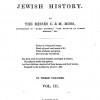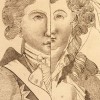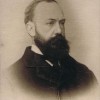
Deborah Epstein Nord, “On Augustus Egg’s Triptych, May 1858”
These three paintings representing the decline of a family as the result of the wife’s presumed infidelity cannot be read in strictly linear fashion, as if they followed the narrative structure of serial fiction. Rather, a reading of the painting that takes into account the spatial and iconographic relationship between the three panels yields the complex and open-ended meaning of the triptych’s story.

Sharon Aronofsky Weltman, “1847: Sweeney Todd and Abolition”
The prolific (but rarely remembered) Victorian playwright George Dibdin Pitt wrote the first Sweeney Todd dramatization in 1847 for the Britannia in London’s East End, tailoring his melodrama for the theater’s particular audience and the acting company’s individual talents. Not published until 1883 in Dick’s Standard Plays (as Sweeney Todd: The Barber of Fleet Street, or The String of Pearls), the printed play differs significantly from Dibdin Pitt’s original, which was initially performed on 1 March 1847 as The String of Pearls, or The Fiend of Fleet Street. Scholars who rely on the 1883 Sweeney Todd to discuss the 1847 melodrama are in many respects talking about a different play. One major difference involves a main character who appears only in the 1847 version. In the 1846-47 novel, a faithful dog named Hector is important to the plot; in the 1847 play, he is transformed into a major heroic character who foils the play’s villains — no longer a dog, but a deaf-mute black boy, a former slave from British Honduras who loyally continues to serve his former owner and current employer out of love and gratitude for his freedom. By including this character, Dibdin Pitt takes an identifiably abolitionist stance, working through what was still England’s strong sense of moral achievement in abolishing slavery and still strong sense of purpose in working to end slavery in the United States. But by 1883, in regards to race and colonialism, the cultural work of Dibdin Pitt’s play without Hector operates through an unthinking backdrop of the Empire’s power and the status quo of racial hierarchy.

Karen Weisman, “Anglo-Jewish Culture and the Condition of England: The Poetry of Marion and Celia Moss”
In 1839, two young Jewish women poets, Marion and Celia Moss, published their first volume of poetry, Early Efforts. It is a volume laden with multiple—and often mutually contradictory—presentations of subjectivity, many of them relating to their Jewish authors’ consideration of England as a nation, an idea, and as an anchor for identity. 1839 also marks the publication date of Thomas Carlyle’s pamphlet, Chartism, in which he invoked “the condition of England question,” a phrase he coined to elucidate his dismay at the plight of the working classes and the consequent upheavals which were then roiling the nation. In bringing these two publications together under the rubric of this essay, I am hoping to shed light on some aspects of the context for Anglo-Jewish Romanticism, especially as it affects the self-understanding of its authors. Our consideration of the condition of England provides a forum in which to understand not only the grounds for agitation on the part of the disenfranchised but also the self-contradictory positions about the idea of England itself taken up with remarkable poignancy by the Mosses in their poetry. In so far as the stability of English identity depends, in part, on the cultural reification of hearth and home within the wider confines of the landscape, basic questions arise about the quotidian reality of English subjects: whose hearth, whose home, whose valorized landscape? These are the questions for the champions of disenfranchised industrial workers no less than for Jewish authors struggling to define an identity within an England which for its Jewish population has been, at turns (and sometimes simultaneously), alienating, sheltering, dismissive, grudgingly tolerant. I appropriate Carlyle’s questions of 1839 as a springboard into a discussion of the Moss poets’ volume of 1839, and its vexed reflections on their experience of England’s condition.

Ellen Malenas Ledoux, “Florizel and Perdita Affair, 1779-80”
This article examines the cultural and political significance of the Prince of Wales’s early 1780s involvement with Drury Lane actress and poet Mary Robinson. Rather than just a romance between two public figures, the “Florizel and Perdita Affair” had wide-ranging effects that, when examined, offer meaningful insight into everything from the weakening influence of the Hanover dynasty and the campaigns of Whig opposition candidates to the aesthetics of formal portraiture, political cartoons, and popular fashion.

Barbara Charlesworth Gelpi, “14 July 1833: John Keble’s Assize Sermon, National Apostasy”
This essay outlines the personal interactions and political events preceding John Keble’s delivery of a sermon later entitled National Apostasy to the judges gathered at Oxford for the Assize Court as a way of understanding the sermon’s significance in relation to the Oxford Movement.

Lorraine Janzen Kooistra, “The Moxon Tennyson as Textual Event: 1857, Wood Engraving, and Visual Culture”
By convention the launch of the so-called “golden age” of wood-engraved illustration in Britain, also known as “the sixties,” is Edward Moxon’s publication, in May 1857, of Alfred Tennyson’s Poems, with 54 wood-engraved illustrations designed by 8 artists, including the Pre-Raphaelites John Everett Millais, William Holman Hunt, and Dante Gabriel Rossetti. Although the Moxon Tennyson was neither a commercial nor critical success on first publication, before the decade was out its Pre-Raphaelite designs were considered a touchstone for artistic illustration, a reputation that continues today. Without disputing the significance of this aesthetic achievement, I want to shift critical focus to the Moxon Tennyson’s status as mass-produced work of art in the age of mechanical reproduction. My interest here is in how its visual communication was expressed through its reproductive technology at the historical moment of its production and reception. This essay re-positions the Moxon Tennyson as a textual event by reading it in the context of documentary, satiric, and artistic wood-engraved images selected from the crucial six-month period after its publication. By situating the Pre-Raphaelite illustrations for Tennyson’s Poems in relation to representations in the public press of such disparate events as the Art Treasures of the United Kingdom Exhibition in Manchester, the reportage on Indian uprisings at Meerut and Cawnpore, the Matrimonial Causes Act, and the Christy Minstrels show in London, I aim to show the complex ways in which the Moxon Tennyson was a worldly event, caught up in, and contributing to, ways of seeing and knowing in 1857.

Susan Hamilton, “On the Cruelty to Animals Act, 15 August 1876”
The Cruelty to Animals Act (15 August 1876) was the world’s first legislation to regulate the use and treatment of live animals in scientific research. This essay overviews the passage and provisions of the legislation, approaching the Cruelty to Animal Act as a site through which to examine the place of animals in clashes between an experimental medical science insisting on its professional and self-regulating status and animal welfare pressure groups that claimed a public right to shape the direction of medical science’s activities.

Mary Jean Corbett, “On Crawford v. Crawford and Dilke, 1886″
Crawford v. Crawford and Dilke was among the first Victorian divorce cases to involve a well-known English politician. It achieved scandalous status in its own time for both its lurid sexual details and its high-profile cast of characters. Focusing less on the chief male actors than its female participants, including Maye Dilke and Virginia Crawford, I consider the response by contemporary feminists to Sir Charles Dilke’s fall from power, as a consequence of his perceived transgressions, and some implications of the scandal for feminist politics in the 1880s and 1890s.

Ellen Rosenman, “On Enclosure Acts and the Commons”
Between 1750 and 1850, approximately 4000 Enclosure Acts were passed converting commonable land into the exclusive private property of large landowners. According to the working-class politics of the late eighteenth and nineteenth centuries, these acts impoverished small farmers and destroyed the agrarian way of life that had sustained families and villages for centuries. Historians have debated this account of their effects, but for the politicized working classes the Enclosure Acts represented a profound trauma, an extended moment in a narrative of dispossession that undergirded resistance to aristocratic power and urbanization.

Ian Duncan, “On Charles Darwin and the Voyage of the Beagle”
The event now known as “the voyage of the Beagle” comprises Charles Darwin’s circumnavigation as ship’s naturalist on the second of three surveying voyages by H.M.S. Beagle; the writings published as his first book, the Journal of Researches; and the genesis of his theory of evolution by natural selection. Writing between regimes of world-knowledge, Darwin mediates scientific observation through the language of aesthetics, and seeks to understand the convergence of disparate scales of geological and human history.
